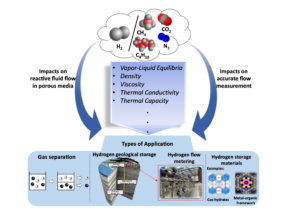
A new user-friendly tool developed by the HyStorPor project will enable low-carbon project developers to accurately calculate the thermodynamic and transport properties of hydrogen mixtures.
The freely available software allows a precise estimate of hydrogen stream properties – such as density, viscosity and thermal capacity – under varying temperature and pressure conditions.
The use of hydrogen as a fuel for heating and industry can significantly reduce our carbon dioxide (CO2) emissions in line with climate targets. However, this depends on large-scale seasonal storage, which can be provided by subsurface porous rocks.
The ability to estimate the properties of hydrogen mixtures will be essential to developing opportunities for hydrogen usage as well as its transport and storage.
The software, H2ThermoBank, designed by scientists at the University of Edinburgh, TÜV SÜD National Engineering Laboratory (East Kilbride, Scotland) and Heriot Watt University, is described in a new paper published in Nature Scientific Data.
The tool uses the established and highly regarded GERG-2008 Equation of State (EoS) and the SuperTRAPP model to calculate the thermophysical properties of hydrogen mixed with methane, nitrogen, CO2 or a typical natural gas from the North Sea.
The software covers a wide range of data for applications, including hydrogen storage, flow metering, gas separation and other types of hydrogen storage purposes – such as gas hydrates and metal-organic framework. It is expected to prove useful for other research as well as for the hydrogen industry.
H2ThermoBank is the latest output from the £1.4 million HyStorPor project, funded by EPSRC, to assess the storage of hydrogen in subsurface porous rocks. The ambitious project, led by the University of Edinburgh, is conducting research into hydrogen as a low-carbon energy vector.
Dr Aliakbar Hassanpouryouzband, principal developer of H2Thermobank and Research Associate at the University of Edinburgh, said: We are working to develop a large-scale, sustainable hydrogen storage system that can provide everyone with access to reliable, low-cost and low-carbon energy. As a result of this study, we now understand hydrogen containing streams better than ever before – from their thermodynamic to transport properties. The science behind calculating the data is intricate, but accessing the data through H2Thermobank is very straightforward.
Dr Edris Joonaki, fluid property expert at TÜV SÜD National Engineering Laboratory, said: The outcome of our research is an informative tool that is useful for all companies, stakeholders, policymakers, and individuals who are interested in building deep understanding of hydrogen transport in porous media and pipelines as well as flow measurement processes through its thermophysical properties.
